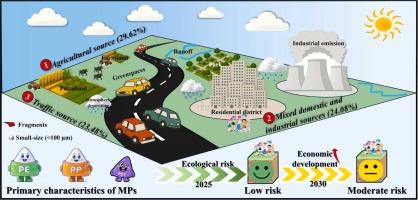基于PMF和可解释机器学习的城市绿地微塑料来源分配和生态风险研究
IF 11.3
1区 环境科学与生态学
Q1 ENGINEERING, ENVIRONMENTAL
引用次数: 0
摘要
微塑料由于其广泛的分布和潜在的生态风险,已成为一个全球性的环境问题。城市绿地在提高城市居民的生活质量方面发挥着至关重要的作用,并受到MPs污染的威胁。虽然以前对MPs的研究主要集中在农业土壤上,但对城市绿地中的MPs污染仍然没有充分的探索。为了解决这一差距,本研究调查了城市绿地MPs污染的空间分布、来源分配以及当前和未来的生态风险。结果表明,MPs丰度在141 ~ 1258个/kg之间。近一半的MPs以片段为主(54.3%),小于100 μm的MPs占49.2%。主要类型为聚丙烯(32.6%)、聚乙烯(27.9%)和聚对苯二甲酸乙二醇酯(12.0%)。来源分配表明,MPs主要来自农业活动(29.6%)、家庭-工业混合排放(24.1%)和交通相关排放(23.5%)。虽然目前MPs对城市绿地的生态风险总体较低,但预计到2030年,经济增长和交通发展将推动未来的风险达到中等水平。本研究全面识别了城市绿地中多聚物的来源和生态风险,为制定城市系统中有针对性的多聚物污染管理策略提供了有价值的见解。本文章由计算机程序翻译,如有差异,请以英文原文为准。

Integration of PMF and explainable machine learning for source apportionment and ecological risk of microplastics in urban greenspaces
Microplastics (MPs) have emerged as a global environmental concern due to their widespread distribution and potential ecological risks. Urban greenspaces play a vital role in improving the quality of life for urban residents, and are threatened by MPs pollution. While previous studies on MPs have predominantly focused on agriculture soils, MPs pollution in urban greenspaces remains insufficiently explored. To address this gap, this study investigated the spatial distribution, source apportionment, and both current and future ecological risks of MPs pollution in urban greenspaces. The results showed that MPs abundance ranged from 141 to 1258 items/kg. Nearly half of MPs were predominantly fragments (54.3 %), and were smaller than 100 μm (49.2 %). The major types were polypropylene (32.6 %), polyethylene (27.9 %), and polyethylene terephthalate (12.0 %). Source apportionment indicated that MPs primarily originated from agriculture activities (29.6 %), mixed domestic-industrial emissions (24.1 %), and traffic-related sources (23.5 %). Although the current ecological risk of MPs to urban greenspaces was generally low, economic growth and transportation development are projected to drive future risk to reach moderate level by 2030. This study comprehensively identified the sources and ecological risks of MPs in urban greenspaces, providing valuable insights for developing targeted MPs pollution management strategies in urban systems.
求助全文
通过发布文献求助,成功后即可免费获取论文全文。
去求助
来源期刊

Journal of Hazardous Materials
工程技术-工程:环境
CiteScore
25.40
自引率
5.90%
发文量
3059
审稿时长
58 days
期刊介绍:
The Journal of Hazardous Materials serves as a global platform for promoting cutting-edge research in the field of Environmental Science and Engineering. Our publication features a wide range of articles, including full-length research papers, review articles, and perspectives, with the aim of enhancing our understanding of the dangers and risks associated with various materials concerning public health and the environment. It is important to note that the term "environmental contaminants" refers specifically to substances that pose hazardous effects through contamination, while excluding those that do not have such impacts on the environment or human health. Moreover, we emphasize the distinction between wastes and hazardous materials in order to provide further clarity on the scope of the journal. We have a keen interest in exploring specific compounds and microbial agents that have adverse effects on the environment.
 求助内容:
求助内容: 应助结果提醒方式:
应助结果提醒方式:


